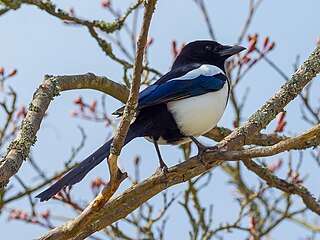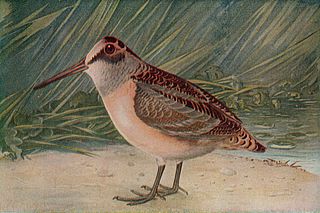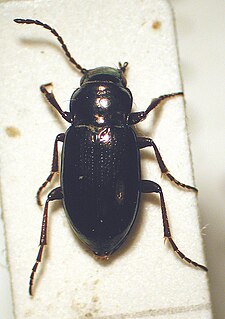
A raven is any of several larger-bodied species of the genus Corvus. These species do not form a single taxonomic group within the genus. There is no consistent distinction between "crows" and "ravens", and these appellations have been assigned to different species chiefly on the basis of their size, crows generally being smaller than ravens.

An eared seal or otariid or otary is any member of the marine mammal family Otariidae, one of three groupings of pinnipeds. They comprise 15 extant species in seven genera and are commonly known either as sea lions or fur seals, distinct from true seals (phocids) and the walrus (odobenids). Otariids are adapted to a semiaquatic lifestyle, feeding and migrating in the water, but breeding and resting on land or ice. They reside in subpolar, temperate, and equatorial waters throughout the Pacific and Southern Oceans and the southern Indian and Atlantic Oceans. They are conspicuously absent in the north Atlantic.

Phalangeriformes is a paraphyletic suborder of about 70 species of small to medium-sized arboreal marsupials native to Australia, New Guinea, and Sulawesi. The species are commonly known as possums, gliders, and cuscus. The common name "possum" for various Phalangeriformes species derives from the creatures' resemblance to the opossums of the Americas. However, although opossums are also marsupials, Australasian possums are more closely related to other Australasian marsupials such as kangaroos.

The true owls or typical owls are one of the two generally accepted families of owls, the other being the barn owls (Tytonidae). This large family comprises 230 living or recently extinct species in 24 genera. The typical owls have a cosmopolitan distribution and are found on every continent except Antarctica.

Fagaceae is a family of flowering plants that includes beeches and oaks, and comprises eight genera with about 927 species. Fagaceae in temperate regions are mostly deciduous, whereas in the tropics, many species occur as evergreen trees and shrubs. They are characterized by alternate simple leaves with pinnate venation, unisexual flowers in the form of catkins, and fruit in the form of cup-like (cupule) nuts. Their leaves are often lobed and both petioles and stipules are generally present. Their fruits lack endosperm and lie in a scaly or spiny husk that may or may not enclose the entire nut, which may consist of one to seven seeds. In the oaks, genus Quercus, the fruit is a non-valved nut called an acorn. The husk of the acorn in most oaks only forms a cup in which the nut sits. Other members of the family have fully enclosed nuts. Fagaceae is one of the most ecologically important woody plant families in the Northern Hemisphere, as oaks form the backbone of temperate forest in North America, Europe, and Asia and one of the most significant sources of wildlife fodder.

Magpies are birds of the Corvidae family. Like other members of their family, they are widely considered to be intelligent creatures. The Eurasian magpie, for instance, is thought to rank among the world's smartest creatures, and is one of the few non-mammal species able to recognize itself in a mirror test. They are particularly well known for their songs and were once popular as cagebirds. In addition to other members of the genus Pica, corvids considered as magpies are in the genera Cissa, Urocissa, and Cyanopica.

Starlings are small to medium-sized passerine birds in the family Sturnidae. The name "Sturnidae" comes from the Latin word for starling, sturnus. Many Asian species, particularly the larger ones, are called mynas, and many African species are known as glossy starlings because of their iridescent plumage. Starlings are native to Europe, Asia and Africa, as well as northern Australia and the islands of the tropical Pacific. Several European and Asian species have been introduced to these areas as well as North America, Hawaii and New Zealand, where they generally compete for habitats with native birds and are considered to be invasive species. The starling species familiar to most people in Europe and North America is the common starling, and throughout much of Asia and the Pacific, the common myna is indeed common.

Minnow is the common name for a number of species of small freshwater fish, belonging to several genera of the family Cyprinidae. They are also known in Ireland as pinkeens.

The woodcocks are a group of seven or eight very similar living species of wading birds in the genus Scolopax. The genus name is Latin for a snipe or woodcock, and until around 1800 was used to refer to a variety of waders. The English name was first recorded in about 1050. According to the Harleian Miscellany, a group of them is called a "fall."

Glyphis is a genus in the family Carcharhinidae, commonly known as the river sharks. This genus was thought to contain five different species, but recent studies on molecular data revealed that the species Glyphis gangeticus has an irregular distribution in the Indo-West Pacific region. This genus contains only four extant species. Further species could easily remain undiscovered, due to their secretive habits. Their precise geographic range is uncertain, but the known species are documented in parts of South Asia, Southeast Asia, New Guinea, and Australia. Of the four currently described species, the Ganges shark is restricted to freshwater, while the northern river shark and the speartooth shark are found in coastal marine waters, as well. While the bull shark is sometimes called both the river shark and the Ganges shark, it should not be confused with the river sharks of the genus Glyphis.

Voles are small rodents that are relatives of lemmings and hamsters, but with a stouter body; a shorter, hairy tail; a slightly rounder head; smaller ears and eyes; and differently formed molars. They are sometimes known as meadow mice or field mice in North America.

The Trachypachidae are a family of beetles that generally resemble small ground beetles, but that are distinguished by the large coxae of their rearmost legs. There are only six known extant species in the family, with four species of Trachypachus found in northern Eurasia and northern North America, and two species of Systolosoma in Chile. They were much more diverse in the past, with many members belonging to the extinct subfamily Eodromeinae, the first fossils known of this family are of the genera Petrodromeus and Permunda from the Permian-Triassic boundary of Russia.

Livistona is a genus of palms, the botanical family Arecaceae, native to southeastern and eastern Asia, Australasia, and the Horn of Africa. They are fan palms, the leaves with an armed petiole terminating in a rounded, costapalmate fan of numerous leaflets.

Nomascus is the second-most speciose genus of gibbons. Originally, this genus was a subgenus of Hylobates, and all individuals were considered one species, Hylobates concolor. Species within Nomascus are characterized by 52 chromosomes. Some species are all black, some are light with a distinct black tuft of crown fur, and some have distinct, light-colored cheek patches. Nomascus is found from southern China (Yunnan) to southern Vietnam, and also on Hainan Island. One species, Nomascus nasutus, has been deemed "the most critically endangered ape species in the world". All species in this genus are either endangered or critically endangered.

The genus Eligmodontia consists of five or six species of South American sigmodontine mice restricted to Bolivia, Chile, and Argentina. Species of Eligmodontia occur along the eastern side of the Andes Mountains, in Patagonia, and in the Chaco thorn forest of South America. They can be found in arid and semiarid habitats and in both high and low elevation areas. These rodents are commonly known as gerbil mice or by their local name lauchas. Sometimes they are also called silky desert mice, highland desert mice or silky-footed mice. The closest living relatives are probably the chaco mice (Andalgalomys), the leaf-eared mice, and Salinomys.

Bettongs, species of the genus Bettongia, are potoroine marsupials once common in Australia. They are important ecological engineers displaced during the colonisation of the continent, and are vulnerable to threatening factors such as altered fire regimes, land clearing, pastoralism and introduced predatory species such as the fox and cat.

Elseya is a genus of large side-necked turtles, commonly known as Australian snapping turtles, in the family Chelidae. Species in the genus Elseya are found in river systems in northern and northeastern Australia and throughout the river systems of New Guinea. They are identified by the presence of alveolar ridges on the triturating surfaces of the mouth and the presence of a complex bridge strut.

Anteater is a common name for the four extant mammal species of the suborder Vermilingua commonly known for eating ants and termites. The individual species have other names in English and other languages. Together with the sloths, they are within the order Pilosa. The name "anteater" is also commonly applied to the unrelated aardvark, numbat, echidnas, pangolins, and some members of the Oecobiidae.

The Scalopinae, or New World moles, are one of three subfamilies of the family Talpidae, which consists of moles and mole-like animals; the other two subfamilies being the Old World talpids and the Chinese shrew-like moles (Uropsilinae). The Scalopinae are the only Talpidae subfamily to consist entirely of undisputed moles and no mole-like close relatives such as shrew-moles or desmans. They are found virtually everywhere soil conditions permit in North America, except northern Canada and those areas of northeastern Mexico where the soil is too sandy. There is also one species in China.

Hog badgers are three species of mustelid in the genus Arctonyx. They represent one of the two genera in the subfamily Melinae, alongside the true badgers.





















